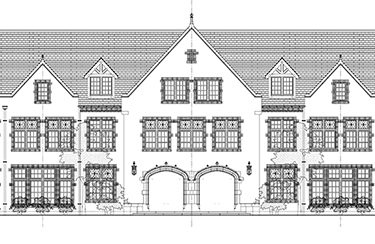|
Subscribe / Renew |
|
|
Contact Us |
|
| ► Subscribe to our Free Weekly Newsletter | |
| home | Welcome, sign in or click here to subscribe. | login |
Construction
| |
 |
August 24, 2017
Why an old church could make a good place for a charter school
Swenson Say Faget

Kanyer
|

Rittereiser
|
In 2012 Washington state voters approved Initiative 1240, allowing up to 40 charter schools to open in five years. The first charter school opened in 2014 for 96 students: First Place Scholars, located in Seattle’s Central District.
In 2015, the Washington Supreme Court ruled that Initiative 1240 was unconstitutional. Charter schools are ruled by a charter school board and not by the local voters. Because of this, the court stated that charter schools do not qualify as “common” schools under Washington’s constitution and therefore cannot receive public funding. Eight charter schools were affected by the ruling.
For the 2015-2016 school year, these eight schools got creative and either regrouped under school districts’ alternative learning programs or as home school centers, or they transitioned to private schools. The Washington State Charter Schools Association raised $4.5 million and used this for bridge grants to help charter schools through the year, and it raised $2 million to kick start more new schools.
In 2016 the state Legislature passed a new law that kept most of the initial 2012 charter school initiative intact, but changed the source of funding.
Charter schools may receive public funding for school construction from state lottery revenue, but not through school district levy funds. They may also receive federal funding. Local school districts may use their apportionment funds to maintain and operate charter schools, but not make improvements to or build new charter schools.
Last September, Washington received a $6.9 million federal grant from the U.S. Department of Education’s Charter Schools Program for three school years, starting with 2016-2017. This public funding is administered by the state Office of Superintendent of Public Instruction.
Currently there are eight charter schools in operation with two more set to open next month, and another two in 2018. Some are managed independently and others are run by charter programs such as Summit Public Schools and Green Dot Public Schools.
Tight budgets
Because public funding does not completely cover the construction costs of charter schools, public-private partnerships are formed to build these schools. Private money comes from entities such as the Charter School Growth Fund, Bill and Melinda Gates Foundation, Charles and Helen Schwab Foundation and many, many others.
Due to the multi-faceted financing aspect, budgets for charter schools are incredibly tight — even tighter than for a typical public school. As a design team, it is our challenge to provide first-class facilities within these constraints. From a structural perspective, that often means repurposing existing buildings and using lower cost materials.
Using existing buildings
One way charter schools have helped mitigate initial construction costs is to repurpose existing buildings. It takes a significant effort by the charter school’s staff or consultants to identify buildings that can potentially be renovated to house classrooms and school support spaces.
Once viable buildings have been identified, building evaluations should be performed to determine if the change of occupancy requires mitigation of any seismic deficiencies. Depending on the building type, retrofit requirements may add significant costs to the renovation.
An accurate building study is directly dependent upon a design team’s adaptive reuse experience and their evaluation techniques. Existing sites could include an unused school district facility, former religious building, warehouse or commercial space.
Once a site is selected, the team may move forward with the most efficient solutions for the owner’s program.
Wood framing
Lower-cost material in the Pacific Northwest means timber. With engineered lumber, a wood-framed structure is a 50-plus-year building — the target for most school districts.
It is important to note that timber does not mean lower quality. It does, however, take early buy-in from the architect and engineer. Wood framing can be type III, IV or V depending on the jurisdiction. (The types identify building materials, combustibility and fire-resistance ratings.)
With careful considerations of the behavior of wood-framed buildings, timber can often be a great solution for both cost and construction timelines. Timber provides flexibility in the field for quick modifications if necessary, but also allows for prefabrication of wall assemblies that can be shipped directly to the site and erected the same day. This can help with quality control during construction as well as provide uniform construction across the entire project.
Bothell charter school
Washington College Prep is an independent charter school slated to open next year in Bothell. The newly built school will ultimately serve students in grades six through 12.
David Lee Architects and Duncan McRoberts Associates are the architects.
The building’s program required three levels with approximately 13,000-sqare-foot floor plates. In order to utilize wood framing, the design team could use type III, or type IV construction.
The design team ultimately decided to use construction type IIIB (which allows a mix of non-combustible and combustible materials) fully sprinklered with two-hour fire-rated exterior walls. This was a cost and material savings over type IV construction (with heavy timber framing requirements) due to simplified connection details and easily sourced materials.
With early research and careful planning by the owner and architect, the decision to use type IIIB construction allowed the design team to take full advantage of wood-framed construction and allocate the money saved toward the exterior cladding system. Delicate stone detailing at the exterior loggia and a deliberate layout to the brick veneer achieved the owner’s goal of creating a classic academic structure for the community.
Charter school construction provides a unique opportunity for design teams to create outstanding and cost-efficient educational spaces for each charter’s specific curriculum. By using an out-to-in approach with existing buildings to determine how to fit the program into the structure, and using creative construction techniques in new construction, multiple solutions can be developed to determine the viability of a project.
Zane Kanyer and Brian Rittereiser are associate principals at Swenson Say Faget.
Other Stories:
- Giant murals give students ‘something to look at and feel proud’
- Seattle’s Lincoln High to reopen 38 years after closing
- Outdoor learning labs let children connect to nature
- Tahoma High project makes the best of a hilly site on former golf course
- North Seattle elementary supports students by opening its doors to families
- Designers study Tinkertoy-inspired school 20 years later to see what worked
- High schoolers get real-life work experience in health sciences building
- 2 new buildings that push students to become more engaged learners
- Classroom wing provides West Sound’s first new STEM space



